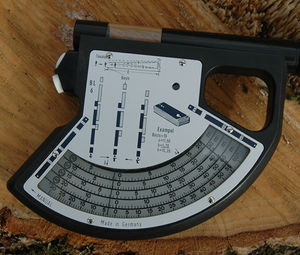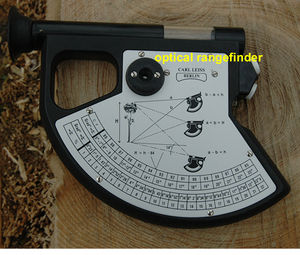Blume-Leiss
| sorry: |
This section is still under construction! This article was last modified on 06/11/2012. If you have comments please use the Discussion page or contribute to the article! |
General description
The Blume Leiss is developed to measure slope and tree heights by the trigonometric principle. The device measures the elevation angle between the operator and measured points. Tree heights can directly be read from the device depending on fixed distances of 15m, 20m, 30m and 40m. For mountainous areas slope correction factors can directly be read from the device depending on the slope. Figure 1 shows the scales of height measurement for the fixed distances to the tree and the scale for slope measurement. This Blume Leiss type is called BL6, which contains 2 buttons which can separately be locked to measure tree bottom and top.
The optical rangefinder (figure 2) allows the user to measure the distance to the tree. Figure 2 shows the back of the device where information
Handling
In [figure 1] you can read the vertical height between the actor, the bottom and the top of the tree. To measure the slope angle the 0-mark of the levelling board [figure 3a] has to be focussed the one of the buttons need to be locked. The distances to the tree can relatively easy be measured through the optical rangefinder [figure 2] focussing the scale bar see [figure 3b].
- If the slope is larger than 5 degrees, the tree heights need to be corrected by the formula e*tan αi. This correction factor (CF) has to be multiplied with the tree height.
- When measuring with Blume Leiss, you need to observe the pendulum check mark to be sure, that the pendulum has stopped oscillating before locking the button.
- !Advantages
- !Disadvantages
- ==Applications==
- ==Related articles==

